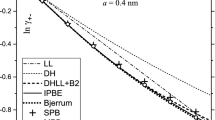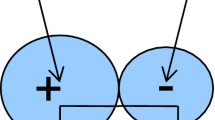Abstract
Individual activity coefficients of single-ion species can be achieved by the factorizing of a new concentration function for the mean activity coefficient to the required power applying a purely mathematical method. These single-ion activity coefficients, calculated in this manner, are listed for some aqueous strong electrolytes. The reasons for the magnitude and variation of the activity coefficients as a function of the concentration are, without a doubt, of complex nature. Activity coefficients have their meaning as practical values. In relation to the analytical concentration, the individual activity coefficients represent the macroscopic effectiveness of the single-ion species in solution an easy manner. However, with increasing deviations from Debye–Hückel conditions of an infinitely diluted electrolyte solution, a physically correct interpretation of the macroscopically visible activity coefficient is becoming more and more difficult, if not impossible to find. On the basis of a model of electrostatic interaction, an attempt has been made to create a qualitative interpretation of the individual ion activity coefficients in concentrated aqueous electrolyte solutions which were calculated applying the purely mathematical method by Ferse.
Similar content being viewed by others
References
Ferse A (1977) Vorschlag zur Berechnung individueller thermodynamischer Aktivitätskoeffizienten einzelner Ionensorten in Elektrolytlösungen bis zu hohen Konzentrationen. Z Phys Chem (Leipzig) 258:257–279
Ferse A, Neumann P (1977) Mathematische Aspekte zu einer Methode zur numerischen Bestimmung individueller thermodynamischer Aktivitätskoeffizienten einzelner Ionensorten in konzentrierten Elektrolytlösungen. Mathem Operationsforschg und Statistik, Ser Statistics 8:529–543
Ferse A (1981) Über individuelle thermodynamische Aktivitätskoeffizienten einzelner Ionensorten von Erdalkalihalogeniden und Erdalkaliperchloraten sowie Uranylperchlorat in wäßriger Lösung bei 25 °C bis zu hohen Konzentrationen. Z Phys Chem (Leipzig) 262:977–995
Ferse A (2008) Zur Problematik individueller thermodynamischer Aktivitätskoeffizienten einzelner Ionensorten in Elektrolytlösungen hoher Konzentration. Z Anorg Allg Chem 634:797–815
Ferse A, Müller H-O (2011) Factorizing of a concentration function for the mean activity coefficients of aqueous strong electrolytes into individual functions for the ionic species. J Solid State Electrochem 15:2149–2167
Ferse A (2012) Some aspects on the problem of individual activity coefficients of single-ion species of aqueous strong electrolytes. Int J Chem (Toronto) 4:45–61
Bates DM, Watts DG (1988) Nonlinear regression analysis and its applications. Wiley, New York
Seber GAF, Wild CJ (2003) Nonlinear regression. Wiley, New York
Guggenheim EA (1929) The conceptions of electrical potential difference between two phases and the individual activities of ions. J Phys Chem 33:842–849
Hamer WJ, Wu Y-C (1972) Osmotic coefficients and mean activity coefficients of uni-univalent electrolytes in water at 25 °C. J Phys Chem Ref Data 1:1047–1099
Staples BR, Nuttall RL (1977) The activity and osmotic coefficients of aqueous calcium chloride at 298.15 K. J Phys Chem Ref Data 6:385–407
Ferse A (1978) Zur Frage individueller thermodynamischer Aktivitätskoeffizienten einzelner Ionensorten in Elektrolytlösungen hoher Konzentration. Z Chem 18:8–15
Ebeling W, Scherwinski K (1983) On the estimation of theoretical individual activity coefficients of electrolytes. I. Hard sphere model. Z Phys Chem (Leipzig) 264:1–14
Kristóf T, Liszi J (1992) Application of the test particle method for the determination of single ion activity coefficients in a real electrolyte solution. Z Phys Chem (München) 178:87–94
Debye P, Hückel E (1923) Zur Theorie der Elektrolyte I. Physik Z (Leipzig) 24:185–206
Debye P, Hückel E (1923) Zur Theorie der Elektrolyte II. Physik Z (Leipzig) 24:305–325
Schwabe K (1986) Physikalische Chemie vol. II, Elektrochemie, 3rd edn. Akademie, Berlin, p 83
Glueckauf E (1964) Bulk dielectric constant of aqueous electrolytes solutions. Trans Faraday Soc 60:1637–1645
Bockris JO’M, Saluja PPS (1972) Approximate calculations of the heats and entropies of hydration according to various models. J Phys Chem 76:2298–2310
Samoilow OJ (1961) Die Struktur wässriger Elektrolytlösungen und die Hydratation von Ionen. G. Teubner, Leipzig (pp. 83–90); the same work was also published in English (1965) Structure of Aqueous Electrolyte Solutions and the Hydration of Ions. Consultants Bureau Enterprises Inc, New York
Lide DR (ed) (2006/2007) Handbook of chemistry and physics, 87th ed. CRC: Boca Raton
Wicke E, Eigen M, Ackermann T (1954) Über den Zustand des Protons (Hydroniumions) in wässriger Lösung. Z Phys Chem [NF] (Frankfurt) 1:340–364
Suhrmann R, Wiedersich I (1953) Dialysis experiments with hydrogen ions in aqueous salt solutions to explain the mechanism of the migration of hydrogen ions. Z Elektrochem 57:93–100
Wang JH, Robinson CV, Edelmann IS (1953) Self-diffusion and structure of liquid water. III. Measurement of the self-diffusion of liquid water with H2, H3 and O18 as Tracers1. J Am Chem Soc 75:466–470
Janoschek R, Weidemann EG, Pfeiffer H, Zundel G (1972) Extremely high polarizability of hydrogen bonds. J Am Chem Soc 94:2387–2396
Roberts NK (1976) Proton diffusion and activity in the presence of electrolytes. J Phys Chem 80:1117–1120
Haggis GH, Hasted JB, Buchanan TJ (1952) The dielectric properties of water in solutions. J Chem Phys 20:1452–1465
Malatesta F (2011) Comment on “Factorizing of a concentration function for the mean activity coefficients of aqueous strong electrolytes into individual functions for ionic species” by A. Ferse and H.-O. Müller. J Solid State Electrochem 15:2169–2171
Ferse A (2011) Reply to the comment by Malatesta on: “Factorizing of a concentration function for the mean activity coefficients of aqueous strong electrolytes into individual functions for ionic species” by A. Ferse and H.-O. Müller. J Solid State Electrochem 15:2173–2175
Acknowledgments
I want to express my thanks to Dr. Hans-Otfried Müller, Technische Universität Dresden, Institut für Mathematische Stochastik, Germany, for the good cooperation in case of the implementation of computer calculations.
Author information
Authors and Affiliations
Corresponding author
Rights and permissions
About this article
Cite this article
Ferse, A. Numerical values of individual activity coefficients of single-ion species in concentrated aqueous electrolyte solutions and the attempt of a qualitative interpretation on a model of electrostatic interaction. J Solid State Electrochem 17, 1321–1332 (2013). https://doi.org/10.1007/s10008-012-1989-8
Received:
Revised:
Accepted:
Published:
Issue Date:
DOI: https://doi.org/10.1007/s10008-012-1989-8




